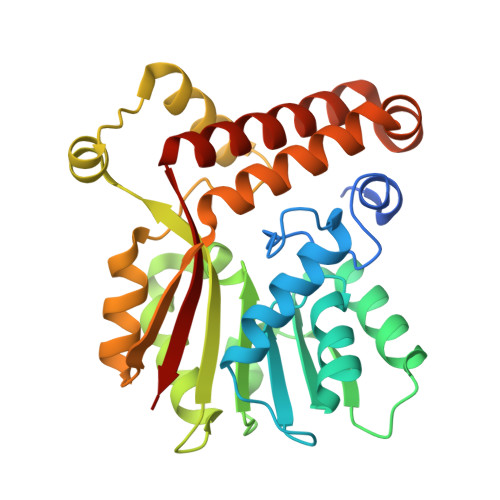Crystal structures of the mycolic acid methyl transferase 1 (MmaA1) from Mycobacterium tuberculosis in the apo-form and in complex with different cofactors reveal unique features for substrate binding.
Chaudhary, B., Kobakhidze, G., Wachelder, L., Mazumdar, P.A., Dong, G., Madhurantakam, C.(2025) J Biomol Struct Dyn : 1-10
- PubMed: 40411373
- DOI: https://doi.org/10.1080/07391102.2025.2483952
- Primary Citation of Related Structures:
8RAQ, 8RBD, 8RBE, 8RBL - PubMed Abstract:
Mycolic acid methyl transferase 1 (MmaA1) protein from Mycobacterium tuberculosis plays a crucial role in the biosynthesis of cell wall mycolic acids that aid in survival of the bacteria under adverse conditions. The enzyme converts a cis to a trans olefin and adds a methyl group at the proximal position of both methoxy and keto-mycolic acid chains. Here we report the crystal structures of apo-MmaA1 and complexes with the cofactor S-adenosylmethionine (SAM), the end-product of methylation reactions - S-adenosylhomocysteine (SAH), and the nucleoside analog Sinefungin (SFG) at 1.4-1.9 Å resolution. These structures reveal the typical seven-stranded α/β fold accompanied by other α-helical embellishments. A dynamic labile loop across the cofactor binding site in the apo-form became relatively rigid upon binding of SAM or SFG but remained labile in the SAH-bound form. A comprehensive analysis of the binding pattern of SAM with MmaA1 reveals critical residues involved in the hydrogen bond interactions with the cofactor, most of which are conserved across other methyltransferases. We also observed a highly conserved cysteine residue (C268) packed against the inner part of the substrate entry channel. C268 is in the reduced state in the SAM-bound but oxidized in the SAH-bound structure. The bulkier sidechain of the oxidized C268 significantly blocks the substrate-binding channel, which might serve as a regulator to control substrate binding and/or selectivity. This atomic view of this critical methyltransferase will build a basis for the identification of small molecule inhibitors against M. tuberculosis.
- Structural and Molecular Biology Laboratory (SMBL), Department of Biotechnology, TERI School of Advanced Studies (TERI SAS), New Delhi, India.
Organizational Affiliation:




















